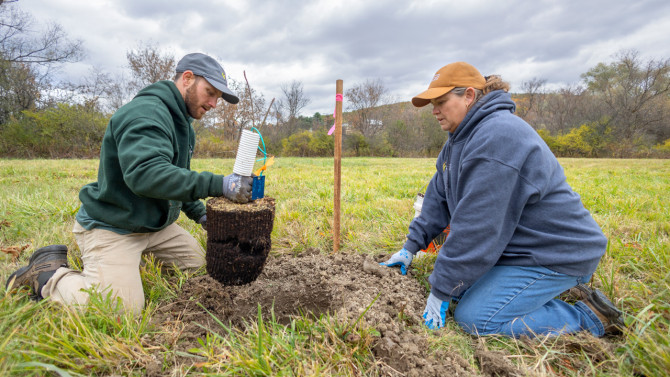Ash saplings newly planted on Cornell land are potentially resistant to devastating emerald ash borer insects, making the university the first propagation center in New York state.
The planting is part of The Nature Conservancy's Trees in Peril project, seeking to restore disappearing ash trees across the country.
Keith Miller, an arborist, and Missy Bidwell, a greenhouse supervisor, both at Cornell Botanic Gardens, plant two-year old lingering black ash at the Gardens' conservation bank site.
Emerald ash borers typically kill all the trees in a stand, but studies by the USDA Forest Service have found that sometimes a few healthy trees - dubbed lingering ash -remain, suggesting they have some natural resistance.
After finding several resistant trees in its natural areas, Cornell Botanic Gardens is collaborating with other conservation partners to propagate more resistant trees. If successful, these trees and their progeny could be used to reforest decimated woodlands in New York State and beyond.
"Our goal is to propagate and conserve trees from 50 to 60 unique parents of green, white and black ash species, and we are thrilled that our first cohort of lingering ash have been planted out in their conservation banks," said Todd Bittner, director of natural areas for the Cornell Botanic Gardens.
Emerald ash borer larvae have decimated black, white and green ash trees by burrowing and eating the living tissue under the bark, which kills the trees. The insects have wiped out ash trees in 37 states, costing billions of dollars for tree removal, treatment and replacement.
When emerald ash borer populations are at lower levels, natural resistance will likely protect trees, but when populations and pest pressures are high, the trees will likely need additional protections, or otherwise would still succumb to the borer, Bittner said.
The Trees in Peril program includes The Nature Conservancy, the USDA Forest Service, experts from academia, research organizations and other partners, all of whom are collaborating to monitor, research and breed pest-resistant American beech, Eastern hemlock, and black, white and green ash.
Cornell is working closely with one of the program partners, the Ecological Research Institute, which is helping to identify lingering ash and collect cuttings, called scion, from trees in New York's Hudson Valley. Trees in Peril has plans for additional propagation centers in New York and the northeast region.
In the meantime, Cornell Botanic Gardens staff will propagate additional resistant trees, maintain the new plantings, and protect them from emerald ash borers and other threats. A total of 139 grafted trees, now between 2 and 7 feet tall, have been planted into three conservation banks, one for each species. The planted saplings were propagated from 26 lingering ash 'parents,' each of which have their own unique genetics for providing resistance to the insects.
As these planted trees mature, Botanic Gardens staff intend to use cuttings from them to propagate more individuals that can then be used for further-out plantings and resistance testing, Bittner said. Cornell breeders hope the plantings will be ready for new scion cuttings in two to four years, with resistance testing of these cloned lingering ash within the decade, once the tress are big enough.
Trees need to be at least 6-8 inches in diameter for emerald ash borers to lay their eggs into the tree and burrow in to feed on the cambium, the living tissue just under the tree's bark.
Researchers have found that most resistant trees will compartmentalize the larvae while they are in earlier life stages.
"Some lingering ash are able to wall off the larvae faster than they can tunnel through, and once they are walled off, they are stuck and they starve to death, because they can't move backwards," Bittner said.
Researchers also suspect a second mechanism for resistance, where the lack of certain volatile organic compounds (VOCs) make the trees chemically invisible to emerald ash borers, so the insects can't locate them for egg laying. There is strong evidence that VOCs are involved with resistance, but more study is needed.
The Ecological Research Institute has started a Monitoring and Managing Ash program, with a call to action for citizen scientists to help identify lingering ash, especially green and black ash that are much less common in New York state. Black ash has cultural importance to Indigenous communities, such as the Haudenosaunee in New York and Canada, who use it for ceremony, weaving and basket-making.
"We are looking forward to the day where ash are returned to our forests, strengthening the health of our ecosystems and the communities that depend on them," Bittner said.








